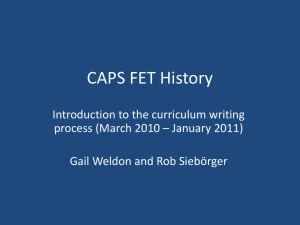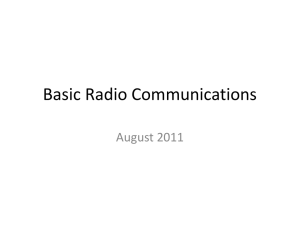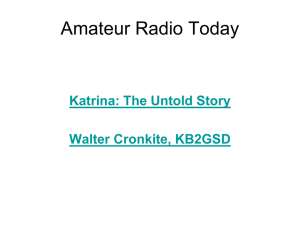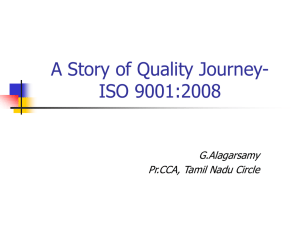gr_10_caps_2011_eng_mml2
advertisement
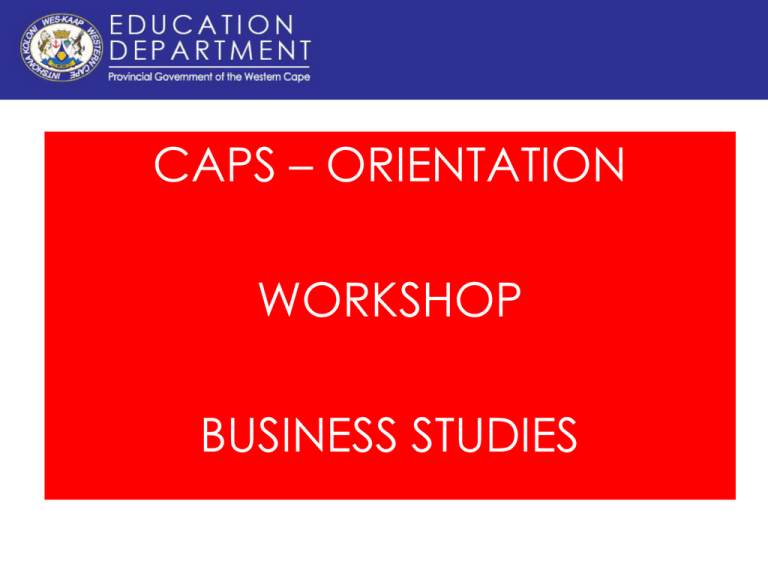
CAPS – ORIENTATION WORKSHOP BUSINESS STUDIES WELCOME ! Teachers Teachers Melanie Lewis Central Education District Topic 1 Welcome & Introduction 2 Introduction – Business Studies 3 Main topics and overview 4 Content links EMS to FET 5 New content 6 Micro environment: NCA & CPA 7 Quality of performance 8 Business Sectors 9 CSR & Entrepreneurial qualities 10 Forms of Ownership 11 Creative Thinking & Contracts 12 Presentation of Business information Time Frame Facilitator MML Topic 13 Methodology & Planning 14 Assessment 15 Examination 16 Moderation Time Frame Facilitator • Be punctual • Note questions: park them • Sign attendance register • Facilities • Cell phones • Respect for participants SMILE BE POSITIVE LISTEN ATTENTIVELY SHARE KNOWLEDGE BE FRIENDLY RELAX TRUST BE HELPFUL PARTICIPATE IN ACTIVITIES SPEAK LOUDLY & CLEARLY PATIENCE GIVE POSITIVE CRITICISM BEFRIEND SOMEBODY PUNCTUAL BE CREATIVE BE PROACTIVE 60 Seconds me and learn I Involve Teach I forget me Tell I me remember and Tell me and I forget. Teach me and I remember. Involve me and I Learn. [ Benjamin Franklin ] Our orientation will cover … Overview of CAPS New subject content Methodology & Planning Assessment, Examinations and Moderation vs. PURPOSE: NCS L E A R N E R S KSV Participate in society Access Higher Education Facilitate transition Educ. Institution to the workplace Profile Competence to employers Comparison between current and amended NCS Current NCS Amended NCS Subject statement s : LPG & SAG Curriculum and Assessment Policy statements [CAPS] 15 15 Comparison between current and amended NCS Current NCS 9 Principles Amended NCS 7 Principles 16 16 PRINCIPLES: NCS Social transformation; Progression; High knowledge and high skills; Human rights, inclusivity, environmental and social justice Credibility, quality and efficiency. Valuing indigenous knowledge systems; and Active and critical learning; Comparison between current and amended NCS Current NCS Amended NCS In Out - OBE - Integration - Portability Active and crtical learning 18 18 Comparison between current and amended NCS Current NCS NCS: Grades 10 - 12 Amended NCS NCS: Grades R - 12 19 19 Comparison between current and amended NCS Current NCS LO’s & AS’s Amended NCS Topics: concepts, knowledge and skills 20 20 Comparison between current and amended NCS Current NCS Amended NCS GET Learning Areas and FET subjects Subjects across the curriculum 21 21 N C S 2 0 1 2 CAPS National Protocol for Assessment Grades R – 12 (January 2012), National policy pertaining to the programme and promotion requirements of the National Curriculum Statement Grades R – 12. National policy for the administration and management of the NSC NCS – 2012 Consists of … National policy pertaining to the programme and promotions requirements of the NCS Grades R - 12 CAPS for each approved school sub ject National policy regarding the administration and management of NCS National Protocol of Assessment Grades R – 12 (January 2012) Implementation Dates • 2011 Preparation of the system for CAPS • 2012 Grade R – 3 & Grade 10 • 2013 Grade 4 – 6 & Grade 11 • 2014 Grade 7 – 9 & Grade 12 QUESTIONS 1. What is the National Curriculum Statement Grades R – 12. ANSWERS Reviewed curriculum policy statement for teaching and learning in SA schools Grade R-12 2. What constitutes the National Curriculum Statement R - 12? CAPS & National policy for each approved school subject as listed in the policy doc. And the National policy pertaining to the programme and promotion requirements of the NCS Grade R-12 3. Why was it necessary to amend the curriculum in 2010? Overload / Confusion / Learner underperformance 4. Which documents/policies have been repealed? NSC – A qualification at level 4 on the NQF An addendum to the policy doc the NSC regarding learners with special needs. Subject statements, LPGs and SAGs for Grade R-9 and Grade 10-12. 5. Which document(s) replace the repealed policies? CAPS per subject The National policy pertaining to the programme and promotion requirements of the NCS Grade R-12 6. What are the principles of the National Curriculum Statement Grades R – 12? How do they differ with those of the National Curriculum Statement Grades 10 – 12? 7 Principles - CAPS p 6 Excl OBE, Integration New: Active and critical learning 7. What are the aims of the National Curriculum Aim to produce learners that are able to: Same as before Statement Grades 10 – 12? Amended: work effectively as individuals and with others as members of a team 8. What are the amendments to the National Curriculum Statement Grades 10 – 12? Subject statement, LPG,SAG replaced with CAPS No Learning Outcomes and ASs – Topics: concepts, knowledge and skills NSCA Qual on level 4 and Addendum learners with special needs – replaced with single Nine principles – replaced with seven GET learning areas and FET subjects – Subjects grade R-12 9. When will the CAPS be implemented? 2012 Grade R-3 & Grade 10 2013 Grade 4-6 & Grade 11 10. How will the implementation of the CAPS be phased in? 2014 Grade 7 – 9 & 12 2012 Grade R-3 & Grade 10 2013 Grade 4-6 & Grade 11 2014 Grade 7 – 9 & 12 11. What is the instructional time for subjects in Home language 4,5 Grade 10-12? FAL 4,5 Mathematics/Maths lit 4,5 LO 2 Three electives 3 x 4 hrs (Bus Stud/Econ) 27,5 hours in 5 days Walk through CAPS document Section 1 Section 2 • Adapted NCS Principles • Aims – adapted critical outcomes • Time Allocation FET Definition, main topics, weightings of topics, purpose, time allocation Section 3 • Grade 10: Overview of topics per term • Summary of Annual Teaching Plan • Teaching PLan Section 4 • Assessment What is Business Studies? The subject encompasses: •Business principles •Theory and practice that underpin the development of entrepreneurial initiatives •Sustainable enterprises •Economic growth •[S E E P] Four main Topics Business Environments Business Ventures Business roles Business Operations Instructional Time Subject Time Allocation per week (hours) 1. Home Language 4.5 2. First Additional Language 4.5 3. Mathematics/Mathematical Literacy 4.5 4. Life Orientation 2 5. Business Studies (+ 2 Electives) 4 x 3 = 12 Time Allocation Term Term 1 Teaching Time in Weeks 10 weeks Teaching Time in hours 40 hours Term 2 8 weeks 32 hours Term 3 10 weeks 40 hours Term 4 6 weeks 24 hours Total 34 weeks 136 hours Content Links : EMS to FET 35 ACTIVITY 2 (20 minutes) • INSTRUCTIONS: – Participants to work in groups – Use: appendix 3 & 4 – Study the EMS and Business Studies content maps and comment on progression of content from one grade to another – How would you as a FET teacher assist or work with your colleague in GET to make sure that learners are being taught this content as a foundation for the subject in FET? – Report back to plenary. 36 ACTIVITY 1 [20 min] INSTRUCTIONS: • Participants to work in groups • USE: CAPS [Pages 13 – 22] Appendix 2 – Overview of topics per term • Complete the columns in appendix 2 by referring to the content in the CAPS document. • Indicate the page number and time allocated in the CAPS document. • Resources: CAPS/ Overview of topics, Khoki pen en flipchart. Overview of Grade 10 Topics TERM TOPICS 1 •Micro environment 2 3 •Contemporary soci- •Creative thinking economic issues and problem •Market solving environment •Social responsibility •Business •Macro environment •Entrepreneurial opportunity qualities •Interrelationship •Business location between •Forms of environments Ownership •Contracts •Business sectors •Business functions included in business environment •Presentation of Business information •Business Plan 4 • Selfmanagement •Relationship and team performance Weighting of Topics Weighting of Curriculum Topic Weeks Business Environment 1. Micro, market and macro environments 8 (weighting 25%) 2. Business sectors 1 3. Contemporary socio-economic issues 3 4. Entrepreneurship 1 Business Ventures 5. Business opportunity and related factors 1 (weighting 25%) 6. Business Plan 3 7. Forms of Ownership 2 8. Contracts 1 9. Business location 1 10. Presentation of business information 1 Weighting of Topics Weighting of Curriculum Business Roles Topic Weeks 11. Creative thinking and problem solving 2 12. Self-management, professionalism & Ethics 2 13. Relationship and Team Performance 2 14. Business Functions - (weighting 25%) Business Operations (weighting 25%) 15. Quality of Performance ( in business environment) 16. All topics divided into terms - 6 Activity (60 minute) INSTRUCTIONS: 1. Study the : * Annual Teaching Plan (CAPS p. 13 – 46) * NCS LPG Grade 10 : 2. Identify the following: – New Grade 10 content in the CAPS (per term) – New Grade 11 content in the CAPS (per term) – New Grade 12 content in the CAPS (per term) – Content moved from other grades to grade 10; and – List the topics identified above (per term) – Methodology to explain new content 3. Choose someone in the group to report back after the group discussions. Content Overview TOPIC GRADE 10 GRADE 11 GRADE 12 Influences, control factors, challenges and adaptation of business environments. Classification of business sectors Formal and Informal sectors Public and Private sectors Identify contemporary socioeconomic issues that impact on business Links between various sectors Business sector and its environment Impact and challenges of contemporary soci-economic issues: intellectual propoerty rights Social responsibility and Social Corporate Responsibility (CSR) Entrepreneurship Entrepreneurial Qualities The concept and how much business embraces entrepreneurial qualities None Business opportunity and related factors Research instrument Business opportunities New ideas None None Micro, market and Components, features and macro environments interrelationship between the three environments Business sectors Contemporary socio – economic issues Devise, evaluate and recommend strategies Recent legislation Content Overview Topic Business Plan GRADE 10 Development of a Business Plan (including a financial analysis) None GRADE 11 Transformation of a business plan into an action plan None Management and Leadership styles and approaches Forms of Ownership Definitions, characteristics, advantages and disadvantages, differences Contribution of form of ownership to the success or failure of business Setting up a business None Establishing a company vs other form of ownership. Formation of companies: MOI Name and Prospectus Starting a business venture based on an action plan Contracts Contracts and their legal implications Factors that impact on business location decisions Avenues of acquiring business (e.g franchising) None Investment insurance Management and Leadership Business location GRADE 12 None None Content Overview TOPIC Investment securities GRADE 10 None GRADE 11 None GRADE 12 Business investment opportunities, e.g. shares Investment None Insurance Presentation of Verbal and non verbal Information presentation of a variety of business information None Investment opportunities: assurance and insurance. Verbal and non verbal; respond Verbal and non verbal; amend professionally to questions and information as necessary. feedback. Creative thinking and problem solving Creative thinking vs successful business practice problem solving. Creative thinking to address business problems and to improve business practice Self management, professionalis m and ethics Concept of self management in a business context. Theories and principles of Professional, responsible, ethical professionalism and ethics. The and effective business principles and skills of practice. Recommendations professional, responsibilities, for improvement. ethical and effective business practice. Creative thinking to respond to challenges in dynamic and complex business contexts. Content Overview TOPIC GRADE 10 GRADE 11 GRADE 12 H Rights, Inclusivity and environ. issues None None Business addresses issues of human rights, inclusivity and environmental issues. Social responsibility Contribution towards immediate community Social responsibility and CSR The citizenship roles and responsibilities Contribute time and effort to advance the well-being of others Stress, crisis, change, conflict management None Concepts relating to stress, crisis and change management. Conflict management skills to resolve differences in business situations. Relationship and team performance Accomplish business objectives. Criteria for successful and collaborative team performance. Team stages and team dynamics, and theories. Achievements of specific objectives. Recap: criteria, stages, team dynamics and theories. Content Overview TOPIC Business Functions GRADE 10 Eight Business Functions Relatedness of business functions GRADE 11 Marketing function, Production function, Introduction to Human Resources function GRADE 12 Legislation regarding Human Resources , employee benefits; skills development The National Credit Act 34 of 2005 and the National Consumer Protection Act 68 of 2008, and their impact on the purchasing function Levels and tasks of general management Quality of Performance Quality in relation to the various None business functions How quality of performance can influence a business Day 2 • Welcome 49 NCA & CPA • Notes will be given • More emphasis on the Consumer Protection Act • What will your approach be? • When teaching be mindful of the cognitive levels wrt assessment. 50 Quality of performance • Notes will be given • Important to note – quality in relation to the business functions • What will your approach be? • When teaching be mindful of the cognitive levels wrt assessment. 51 BUSINESS STUDIES GRADE 10 TOPIC: BUSINESS SECTORS Formal and informal Difference between Formal Sector & Informal Sector Difference between Formal Sector & Informal Sector 1.Description 2.Examples 3.Characteristics Description: Formal & Informal sector Formal sector • refers to all businesses • that employ workers • which offer regular wages • and regular working hours, • with them employment rights, • and on which income is taxed Informal sector • refers to all businesses • that employ workers • whose wages are very low • and working hours irregular • with no employment rights • and on which no tax is paid for the income Examples: Formal & Informal sector Formal Sector • • • • • Pick ‘n Pay Mr. Price Standard bank Interflora Toyota service centre Informal Sector • • • • • Spaza Shop Flea market Loan Shark Flower sellers Backyard mechanic Characteristics: Formal & Informal sectors Formal Sector Informal Sector • Business is registered • Business not registered • Pay taxes • Keep record of business activities • Regular working hours • Regular wages paid • Employees rights protected • Do not pay taxes • Do not keep accurate record of business activities • Long working hours • Low wages paid • Employees rights not protected Difference between Public Sector & Private Sector Difference between Private Sector & Public Sector 1.Description 2.Examples 3.Characteristics Description: Formal & Informal sector Private sector • consist of privately owned business • that produce goods and services • with the aim of making a profit Public sector • consist of organisations or institutions • that are owned by the government • or were set up by government • with taxpayers money Examples: Private Sector & Public Sector Private Sector Public Sector • M-NET • SABC • • • • • • • • • • Intec College Postnet South African Airways MTN Gatesville Med Centre Mandela High School SA Post Office Kalula.com Telkom Groote Schuur Hospital Characteristics: Private & Public Sector Private Sector • owned by private individuals • financed from own sources, loans or shares issued • objective to make a profit • end beneficiary is the general paying public Public Sector • owned by government • financed from taxes or loans • not profit driven • end beneficiary is the general public CSR & Entrepreneurial qualities • Notes will be given; • What will your approach be? • When teaching be mindful of the cognitive levels (identify entrepreneurial questions) wrt assessment. NOTES Forms of Ownership Forms of Ownership 1 Sole Trader 2 Partnership 3 Close Corporation 4 Private Company 5 Personal Liability Company 6 Public Company 7 State Owned Company 8 Non- Profit Company Forms of Ownership – Activity [60 min] • Divide the forms of ownership amongst the group • Decide on a scribe and spokesperson in your group • The group will summarise: - Legal prescriptions - Registration requirements - Legal person - Tax reliability - Liability - Management - Payment to owners • Summaries to be pasted on the walls • Group leader explains the concepts to the group [Gallery walk] Forms of Ownership The differences between the Companies act 71 of 2008 & Act 61 of 1973 KWARTAAL 1 • Creative Thinking and Problem solving Techniques added: [SCAMPER ] • Contracts – Legal implications, Parties, Rights and responsibilities • Presentation of information Creative Thinking and Problem solving techniques: [SCAMPER] • • • • • Problem solving To unlock creativity Provide solutions to problems or challenges Use ideas that already exist Find solutions S Substitute Replace aspects of the problem C Combine Ideas/sections/elements combined A Adapt Making adjustments to ideas that exist already M Modify Change something P Put to Other uses Make use of solutions E Eliminate Eliminate some aspects R Re-arrange Rearrange things Activity: SCAMPER • Identify elements of SCAMPER that can be applied to a Blackberry cellphone to transform it from the first model cellphone that was available. From the OLD to the NEW S C A M P E R NOTES Contracts: Legal implication, parties, rights and responsibilities • Discuss the legal implications of the NCA and CPA on the following contracts in different business contexts: • – – – – Employment Insurance Renting agreements Installment agrreements Hire – purchase agreements Contracts - notes NOTES Presentation of Information • Definition of audio visual aids • Design and layout of presentation using different visual aids • Integrate with Media Research CASS Assignment (2nd Term) Session 12 Relationship and team performance • Assessment of a team against criteria for successful and collaborative team performance. KWARTAAL 1 • Relationship and team performance Working in a team to accomplish business objectives Groep 2 Groep 1 Clear objectives and agreed goals Sound inter – team relations Openness Solving problems and goal setting in teams Mutual respect Shared Values Support and mutual trust Individual development Groep 3 Groep 4 Interpersonal relations and behaviour Review of teamwork Good communication Conflict management Planning Leadership Committed to achieving goals Decision making Activity 7 • Assess your teams performance against the criteria for team assessment • Report back Lunch 12.30 – 13.00 Methodology & Planning Methodology • Teaching approach • Use of different strategies • Managing diversity in the classroom 86 Summary of Planning • Planning is important and necessary • For accountability to parents, officials and other role players • A proper annual teaching plan gives teachers a plan in terms of content, resources, assessment, starting and completion time. • Need for proper lesson planning Planning SUBJECT: _________________________ GRADE: ______ Topic Content Date started Completion date Resources used •Lesson preparation in the teachers working file. •. HINT: Convert annual teaching plan electronically; hard copy •Learner note books as evidence of teaching and learning process. TERM: ___ Assessment Learners – Textbook – Notebook • Other resources Teachers – Variety of text books and other resources for example: • Companies Act, 71 of 2008, • Employment Equity Act No. 55 of 1998, • National Credit Act No. 34 of 2005, • Consumer Protection Act No. 68 of 2008, • Basic Conditions of Employment Act No. 75 of 1997, Teacher • Labour Relations Act No. 66 of 1995, • Black Economic Empowerment Act No.53 of 2003, • Skills Development Act No.97 of 1998, • Compensation for Occupational Injuries and Diseases Act No. 130 of 1993, • Hire Purchase Act, • Long-term Insurance Act 52 of 1998, • Short-term Insurance Act 53 of 1998, etc. • Memorandum of Incorporation (MOI) - new founding document of a company • Specimen of contract forms • Bank brochures • Business and financial magazines • Corporate Social Responsibility (CSR) Policy – Textbook LTSM Effective tool for teaching and learning Presents all the topics in the content overview Knowledge and concepts are well scaffolded to provide understanding and insight Variety of activities/exercises that are clear and address different cognitive levels. NB: Each learner should have a textbook per subject to take home to study from and do homework. Teacher File Every teacher must have a file as planning instruments or evidence The Annual Teaching Plan A record of start and end dates of lessons Assessment Plan Formal Assessment tasks and memoranda/assessment tool List of Text books and other LTSM used Recording Sheets of learners individual marks for all formal assessment tasks Any interventions used for the class or individual learners, especially learners with barriers to learning ASSESSMENT & EXAMS What is assessment ? - Identifying knowledge Demonstrated to learners - Gathering - Interpreting information and skills Formal and Informal Assessment Assessment INFORMAL Daily Assessment Recording Optional Strengthen teaching and learning FORMAL Programme of Assessment Recording Used for promotion/certification 95 95 Informal and Formal Assessment Cont. Informal Daily assessment Formal Programme of Assessment Monitor learner’s progress Systematic way of evaluating learner progress Used for promotion / certification Improve teaching Scaffold learning Recorded Stepping stones to tasks in Programme of Assessment Not required to record 96 Programme of Assessment POA Grade 10 Examinations Two End of year Mid-year 200 marks Tests Two Assignment, Project and Presentation First and Third Terms Terms 1, 2 & 3 = 3 x 50 = 100 Not tests and exams 300 marks reduced to 75% End of year 75% 25% Tasks during the year 97 97 97 Programme Of Assessment The Programme of Assessment in Grade 10 Assessment Total marks Term 1 Term 2 Term 3 Assignment Test (Case study – all 3 cogn levels incl 30%/50%/ 20%) Presentatio Midn year (Med Research topics term 1,2 ) Project Test (Bus Plan 50 50 50 100 200 Term 4 Year markFinal exam Total or Research Project, covering cogn levels 1-3, 30%/50%/2 0%) 100 550 300 Converted to 550÷5.5 300 400 a mark out of: =100 Note: In Grade 10 the Seven Assessment tasks make up the Programme of Assessment. Refer to Protocol on Assessment. 1. A Project (can be any topic covered in the 3rd term, but the BUSINES PLAN must still be done in class) 2. Tests & Exams Control Tests – terms 1 and 3 / Mid year exam / Year end Exam 3. Written or practical assignments (One Task – 1st term / One presentation 4. Presentation Term 2 – any topic covered in term 1 or 2 – must provide evidence Must cover all topics. Hand in to SMT at the end of previous year – school use to compile school assessment plan. Forms of Tasks Other forms of tasks excluding tests and exams – Number of tasks: 3 per year as per Protocol on assessment – Controlled conditions – Facilitated during class time by teacher (!) – Certain aspects could be done at home e.g. sourcing information, planning, etc. 100 Forms of Tasks TESTS: • Two tests: – First and Third terms • • • • 100 marks each Scheduled Controlled conditions Not to be made up of a series of small tests 101 Forms of Tasks Grades 10 - Examinations • Two exams: – Midyear and End-of-Year – All internal / school-based •Duration to protect contact time –Two weeks per exam for internal examinations (according to Annual Teaching Plan) –End-of-Year exams not to start before November 102 Examination Content stipulated specifically for the grade 100% Cognitive levels Basic thinking skills (e.g. factual recall, low-level application and low-level comprehension) Moderately high thinking skills (e.g. more advanced application, interpretation and low-level analysis) Higher-order thinking skills (e.g. advanced analytical skills, synthesis and evaluation) 30% 50% 20% Mid-year examinations Below is an outline of the structure of the mid-year examinations in each of the grades: Grade 10 Paper 1 Time 2 hours Marks 200 Topics As per Grade annual teaching plan 103 Examination End-of-year examinations Grade 10 should write a 3-hour examination of 300 marks as a final examination. Paper Time Grade 10 1 Marks Business Business EnvironmentVenture 3 hours 300 25% 25% Business Role 25% Business Operation 25% Structure of the Examination Paper . GRADE 10 11 12 EXAMINATION PAPER GUIDELINE 105 MODERATION Moderation of assessment • Moderation refers to the process that ensures that the assessment tasks are fair, valid and reliable. • Moderation should be implemented at school, district, provincial and national levels. • Comprehensive and appropriate moderation practices must be in place for the quality assurance of all subject assessments. 107 Moderation of assessment • All Grade 10 tasks are internally moderated, • The subject head for Business Studies or Head of Department for the Business, Commerce and Management subjects at the school will generally manage this process. • Moderation at the school will be carried out at least once per school term. 108 Moderation • HoD (or subject head) if HoD did not specialise in subject • All PoA tasks: HoD moderates before task is given to learners • HoD moderates 10% of learner responses to PoA tasks and marking instruments. 109 Instruction - Moderation Activity • Participants form groups of 3 – 10 • Discuss the challenges that you encounter when doing SBA moderation. How can you overcome those challenges? • Report back and discussion.( 10 min) 110 Moderation of POA task: What to look for? • Internal: Internal Moderation checklist to be completed for each task and learner scripts/tasks • External: Make use of cluster moderation checklist • Aspects to be moderated: e.g. • Duration, length ( in case of a test and examination) • Weighting of content • Weighting of cognitive levels • Language used. • Use of pictures, diagrams, graphs to facilitate language • Level of difficulty • Other? 111 CAP ACITATE CAP TAIN CAP TIVATE CAP ABLE

